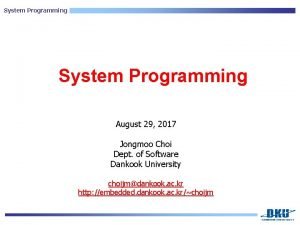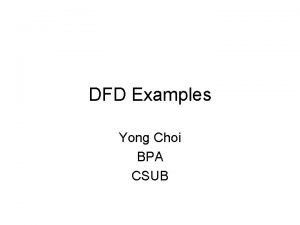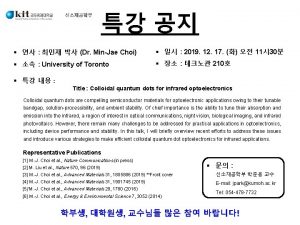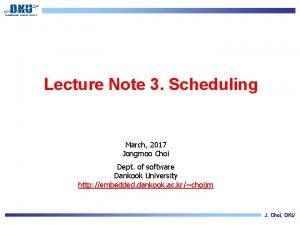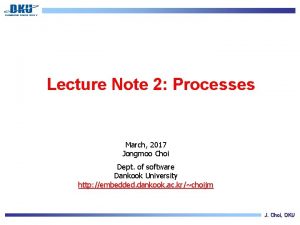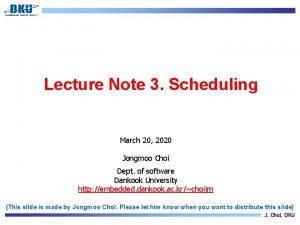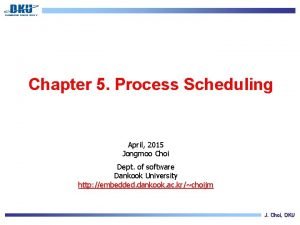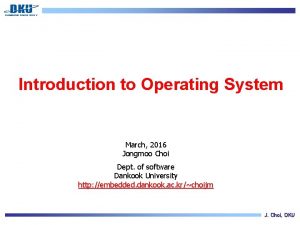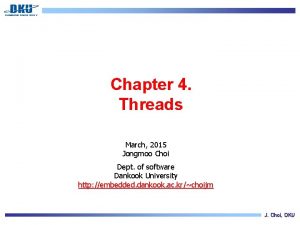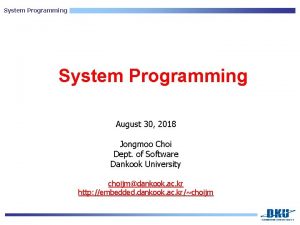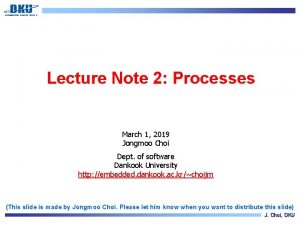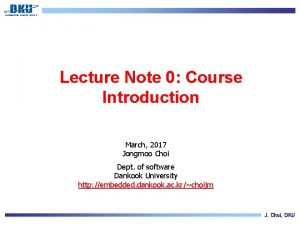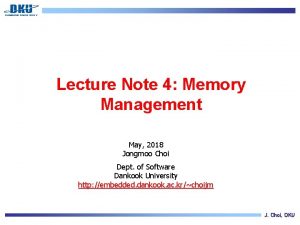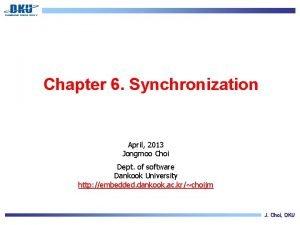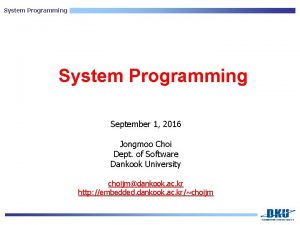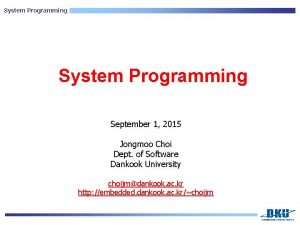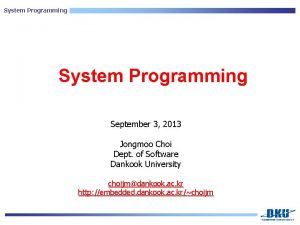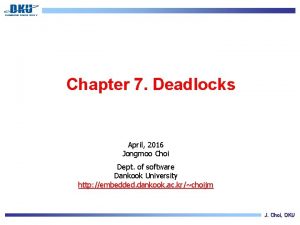Lecture Note 3 Scheduling March 2018 Jongmoo Choi








































- Slides: 40

Lecture Note 3. Scheduling March, 2018 Jongmoo Choi Dept. of software Dankook University http: //embedded. dankook. ac. kr/~choijm J. Choi, DKU

Contents From Chap 7~11 of the OSTEP Chap 7. Scheduling: Introduction ü ü ü Workload assumptions and Scheduling Metrics Algorithms: FIFO, SJF, STCF, RR Incorporating I/O Chap 8. Scheduling: MLFQ (Multi-Level Feedback Queue) ü ü ü Basic rules Attempts: Change priority, Boost priority, Better accounting Tuning MLFQ and other issues Chap 9. Scheduling: Proportional Share ü ü Basic concept: Tickets represent your share Ticket mechanism, implementation, example and issues Chap 10. Multiprocessor Scheduling ü ü Background, cache affinity Scheduling: single queue, multi-queue Chap 11. Summary Dialogue on CPU virtualization 2 J. Choi, DKU

Chap 7. Scheduling: Introduction Scheduling ü ü Multiple actors want to use (limited) resources at a time Select actors who can use the resources Process Scheduling ü ü Actor: process, Resource: processor (CPU) Select a process who run on a processor (or processors) ready CPU 2 CPU 1 running 3 J. Choi, DKU

7. 1 Workload assumption Workload ü ü The amount of work to be done (dictionary) How much resources are required by a set of processes with the consideration of their characteristics (in computer science) Assumption about processes (also called as job in the scheduling research area) in a workload considered ü Each job runs for the same amount of time All jobs arrives at the same time Once started, each job runs to completion All jobs only use the CPU (no I/O) The run-time of each job is known in advance ü c. f. ) unrealistic, but we will relax them as we go ü ü 4 J. Choi, DKU

7. 2 Scheduling Metrics Metric ü Something that we use to measure (e. g. performance, reliability, …) Metrics for scheduling ü Turnaround time § Tturnaround = Tcompletion - Tarrival ü Response time § Tresponse = Tfirstrun - Tarrival ü Fairness § E. g. ) Tcompletion of P 1 vs that of P 2 ü Throughput § E. g. ) number of completed processes / 1 hour ü ü Deadline …. What do you think first when we choose a restaurant for lunch? What does the owner of the restaurant think first? 5 J. Choi, DKU

7. 3 FIFO (First In, First Out) FIFO ü ü Schedule a process that arrives first (a. k. a FCFS (First Come First Serve)) Example § 1) three processes: A, B, C, 2) run-time: 10 seconds, 3) arrival time: 0 s (tie-break rule: alphabet in this example) § What is the average turnaround time? ü Another example § 1) three processes: A, B, C, 2) run-time: 100 s for A, 10 s for B and C § Now, what is the average turnaround time? 6 J. Choi, DKU

7. 3 FIFO (First In, First Out) FIFO ü Pros) § 1) Clearly simple, 2) Easy to implement ü Cons) § 1) May cause a long waiting time (known as convoy effect) (Source: http: //web. cs. ucla. edu/classes/fall 14/cs 111/scribe/7 a/index. html) How can we overcome this long waiting? 7 J. Choi, DKU

7. 4 SJF (Shortest Job First) SJF ü Give a higher priority to the shortest job (a. k. a Shortest Process Next (SPN)) § “ten-items-or-less” in a grocery store ü Revisit the previous example again § 1) three processes: A, B, C, 2) run-time: 100 s for A, 10 s for B and C § What is the average turnaround time? ü Pros) § Proved as an optimal algorithm ü Cons) § What if B and C arrive a little bit late than A? (e. g. assume 10, not 0) 8 J. Choi, DKU

7. 5 STCF (Shortest Time-to-Completion First) STCF ü ü Similar to SJF, but preemptive version (a. k. a Shortest Remaining. Time next (SRT)) Non-preemptive scheduling § Run a job to completion ü Preemptive scheduling § Can stop a job (even though it is not completed yet) to run another job § All modern schedulers are preemptive § Require the context switch ü Example § 1) three processes: A, B, C, 2) run-time: 100 s for A, 10 s for B and C, 3) arrival time: 0 s for A, 10 s for B and C. 9 J. Choi, DKU

7. 6 Response time Turnaround time ü A good metric for batching systems How about a time-sharing system? ü ü ü User would sit at a terminal, working something interactively (e. g. move a mouse, type in a letter, visit a site, and so on) Response time is more important Example with SJF What is the average turnaround time? How about the average response time? Imagine that you move a mouse and wait for a 5 s. 10 J. Choi, DKU

7. 7 RR (Round-robin) RR ü ü ü Instead of running a job to completion, it runs a job for a time slice (sometimes called a scheduling quantum) and switch to the next job in the run queue Repeatedly switch jobs until jobs are finished Example § § 1) three processes: A, B, C, 2) run-time: 5 s, 3) arrival time: 0 s RR with time slice = 1 s What is the average response time? What is the average turnaround time? What if the time slice is set as 100 ms or 10 ms. Discuss tradeoff 11 J. Choi, DKU

7. 7 RR (Round-robin) Tradeoff of time quantum ü ü ü Small: good responsiveness, high context switch overhead Large: low context switch overhead, bad responsiveness Assume that the time quantum is 100 ms in the previous slide example § What is the average response time? § How about in the viewpoint of overhead when we assume that the context switch time is 1 ms? Tradeoff between response time and turnaround time ü ü Traditional issue in computer science: interactivity(fairness) vs performance You can not have your cake and eat it too. 12 J. Choi, DKU

7. 8 Incorporating I/O Most of applications do I/Os Example ü ü Two jobs A and B, both need 50 ms of CPU time A runs for 10 ms and then issue an I/O request (it takes 10 ms) Scheduling results ü ü ü Busy waiting: Figure 7. 8 Blocked: Figure 7. 9 How to implement the Figure 7. 9 Multi-Level Feedback Queue 13 J. Choi, DKU

7. 9 No More Oracle How to predict the length of a job (service time)? ü ü By user specification By prediction (approximation) § The CPU time length will be similar in length to the previous ones (characteristics of program behavior) exponential moving average where § Validation with =0. 5 and 0=10 ( determines the weight of each history) (Source: A. Silberschatz, “Operating system Concept”) 14 J. Choi, DKU

8. MLFQ Existing scheduling policies ü ü SJF, STCF: good for turnaround time, terrible for response time RR: vice versa How to optimize the turnaround time while minimizing response time? ü MLFQ (Multi-Level Feedback Queue) § By F. Corbato (Turing Award Winner) § Approach: Learn from the past to predict the future 15 J. Choi, DKU

8. 1 MLFQ: Basic Rules MLFQ ü ü Consist of multiple queues Each queue is assigned a different priority level A job that is ready to run is on a single queue (running or blocked jobs are out of the queues) A job with higher priority (a job on a higher queue) is chosen to run next (RR among jobs in the same queue) 16 J. Choi, DKU

8. 2 Attempt #1: How to Change Priority How to assign a priority to each process? ü Not fixed, change the priority of a job based on its observed behavior § Recently do I/Os Interactive High priority Highest queue § Use CPU intensively batch Low priority Next lower-level queue 17 J. Choi, DKU

8. 2 Attempt #1: How to Change Priority Examples ü Example 1: A Single Long-Running Job Fig. 8. 2 § Assumption: Three queues (Q 2, Q 1, Q 0), one job, 10 ms time slice ü Example 2: A long and short Job Fig. 8. 3 § Assumption: two jobs, A: long-running job, B: short-running job § Just arrived job MLFQ presumes the job is a short job Give high priority • • ü Really a short job: run quickly and complete (approximates SJF) If not: move down the queues, proving itself as a long-running Example 3: What about I/O? Fig. 8. 4 § Assumption: two jobs, A: long-running job, B: short-intensive job § MLFQ keep a process at the same queue if it gives up CPU before using up its time slice (rule 4 b) • Prefer I/O intensive job for good response time 18 J. Choi, DKU

8. 2 Attempt #1: How to Change Priority Problem with our current MLFQ ü Pros of the current version § Share CPU fairly among long-running jobs § Allow short-running or I/O intensive jobs to run quickly ü Issues § Starvation • if there are “too many” interactive jobs, long-running jobs will never receive any CPU time (they starve) § User can trick the scheduler (game the scheduler) • Just before the time slice over, issue an I/O request remain in the same queue unfairly § A program may change its behavior • CPU-intensive at the first phase interactive at the later phase (e. g. service user request after long initialization) 19 J. Choi, DKU

8. 3 Attempt #2: The Priority Boost New rule for avoid starvation ü One approach: periodic boosting ü Example § Three jobs, two interactive jobs and one long-running job § Priority boost every 50 ms 20 J. Choi, DKU

8. 4 Attempt #3: Better Accounting How to prevent gaming of MLFQ scheduler? ü Change the rule 4 a and 4 b instead of forgetting how much of a time slice a job used at a given queue, keep track it. Once a job has used its allotment, it is demoted to the next queue 21 J. Choi, DKU

8. 5 Tuning MLFQ and Other Issues Parameters ü Issues § How many queues? § How big should the time slice be per queue? Same or Different? § How often do the priority boost? ü Many MLFQ variants with diverse parameter settings § Different time slice per queue: shorter for higher priority queue and vice versa (10 ms, 20 ms and 40 ms in Fig. 8. 7) § Solaris case: Table based § BSD, Linux: Decay based (mathematical) § Support user advice (e. g. nice system call) (Source: A. Silberschatz, “Operating system Concept”) J. Choi, DKU 22

8. 6 MLFQ: Summary Name analysis ü ü Multi-level: multiple queues Feedback: based on history (track job’s behavior over time and treat them accordingly) Final rules Features ü Try to good both for short-term interactive jobs and long-term CPUintensive jobs 23 J. Choi, DKU

8. 6 MLFQ: Summary Scheduling example: process set (Source: “Operating systems: Internals and Design Principle” by W. Stalling) J. Choi, DKU

8. 6 MLFQ: Summary Scheduling example: execution order (Source: “Operating systems: Internals and Design Principle” by W. Stalling) J. Choi, DKU

Chap 9. Scheduling: Proportional Share (fair share) ü ü Concept: instead of turnaround time or response time, it tries to guarantee that each job obtain a certain percentage of CPU time Scheduling algorithms: Lottery, Stride, … J. Choi, DKU

9. 1 Basic Concept: Tickets Represent Your Share Lottery scheduling ü ü ü Made by Waldspurger and Weihl Schedule a job who wins the lottery A job that has more tickets has more chance to win § Ticket: represent the share of a resource § Two jobs, A has 75% tickets while B has 25% tickets win probability with 75% and 25% 75% of CPU is expected to be used by A ü Example § Total tickets: 0~99, A: 0~74, B: 75~99 § 80% for A, 20% for B in this example (since it is based on probability). But, the longer it runs, the more likely it achieves the desired share J. Choi, DKU

9. 2 Ticket Mechanisms Ticket currency ü ü Allow users to allocate tickets among their own jobs with correct global value Example § § Two users, A: 100 tickets, B: 100 tickets A has two jobs. A gives them each 500 tickets B has only one job. B gives it 10 tickets How many tickets are given into three jobs with a global viewpoint? Ticket transfer ü ü A job temporarily hands off its tickets to another job Especially useful in a client/server environment Ticket inflation ü Temporarily raise or lower the # of tickets (in a cooperative env. ) J. Choi, DKU

9. 3 Implementation Benefit of Lottery scheduling ü Simplicity § All it needs are 1) random(), 2) counter and 3) ticket at each job ü Example § Three job (see figure) § Assume that we pick the number 300 schedule C J. Choi, DKU

9. 4 An Example & 9. 5 How to Assign Tickets? Unfairness analysis ü ü Assumption: two jobs, same ticket, same run time (e. g. 10 ms * N) U = C 1/C 2 § C 1: Completion time of the earlier finished job § C 2: Completion time of the later finished job § Implication (assume that N = 1) • • • C 1=10, C 2=20 U = 0. 5 (worst fairness) C 1=20, C 2=20 U = 1 (best fairness, ideal) Long running Fig. 9. 2 How to assign tickets? ü ü ü Money Cloud computing Priority Soft RT system … J. Choi, DKU

9. 6 Why Not Deterministic? Lottery scheduling ü Not deterministic (rely on random number generator) Stride scheduling ü ü A deterministic fair-share scheduler Stride: inverse in proportion to the # of tickets § Schedule a job who has the smallest pass value § Increment the pass value by its stride ü Example § Three jobs: A, B, C, Tickets: 100, 50, 250 § Stride: 100, 200 and 40 (divide 10000 by ticket) J. Choi, DKU

Chap. 10 Multiprocessor Scheduling (Advanced) Multiprocessor and multicore ü ü ü Multiprocessor: a system with multiple processors Multicore: a chip (socket, processor) with multiple cores Modern computer equips with multiple processors with multicore (with hyperthread) Manycore For utilizing multicore effectively ü ü Typical C program: use only one CPU (serial program) make parallel program (e. g. using thread) Need a scheduler that can handle multiple CPUs J. Choi, DKU

10. 1 Background: Multiprocessor Architecture CPU cache (L 1, L 2, LLC) ü Small, fast memory that generally hold copies of popular data (based on temporal and spatial locality) § Temporal locality: when a data is accessed, it is likely to be accessed again in the near future (e. g. stack, for loop, …) § Spatial locality: when a data is accessed, it is likely to access data near x as well (e. g. array, sequential execution, …) ü Benefit § Cache hit: make a program run fast by reducing access to the relatively slow main memory § Delayed write: modified data are kept in cache, not writing immediately into memory so that it possibly merges consecutive writes into a single memory access J. Choi, DKU

10. 1 Background: Multiprocessor Architecture CPU cache is much complicated in Multiprocessor ü Cache coherence: maintain coherence among caches § § § ü A program running on CPU 1 reads data from address A CPU 1 fetches the data and keep it its cache (assume its value is D) The program modifies D into D’. CPU 1 applies the delayed write OS decides to schedule the program into CPU 2 (due to load balancing) The program re-read the value from address A. The value is the old one(D), not the correct one (D’) incoherent Bus snooping: one of mechanisms for supporting coherence § Monitoring cache, Invalidate or update if data is modified J. Choi, DKU

10. 2 Synchronization & 10. 3 Cache affinity Issues on Multiprocessor ü Synchronization: mutual exclusion on shared data § Will be discussed in chapter 25~34 ü Cache affinity § When a process runs, it is often advantageous to run it on the same CPU where the process ran previously § Since the CPU might build up a state in the cache (and TLB) for the process https: //www. youtube. com/watch? v=f. SUq. T 4 Wp. Pd. M J. Choi, DKU

10. 4 Single-Queue Scheduling SQMS (Single Queue Multiprocessor Scheduling) ü ü ü Use the framework for single processor scheduling Pros: simplicity Cons: cache affinity (5 jobs and 4 CPUs example, need to some complex mechanism to support cache affinity to obtain the below right figure), scalability (especially due to lock for shared queue) (without affinity consideration) (with affinity consideration) J. Choi, DKU

10. 5 Multi-Queue Scheduling MQMS (Multi-Queue Multiprocessor Scheduling) ü Multiple queues, Jobs assigned a queue, Each queue is associated with a CPU (or a set of CPUs) Pros: cache affinity, less lock contention ü Cons: need to consider load balancing (migration, work stealing) ü J. Choi, DKU

10. 6 Linux Multiprocessor Schedulers (Optional) Three different schedulers ü O(1) scheduler § Multi-queue, similar to MLFQ (schedule higher priority, priority are changed dynamicaaly) ü CFS (Complete Fair Share Scheduler) § Multi-queue, similar to stride scheduling (deterministic proportional share scheduling) ü BF Scheduler § Single-queue, proportional share with more complicate scheme J. Choi, DKU

Chap 11. Summary Dialogue on CPU virtualization What we have learned ü ü Mechanism: Context switch, Timer interrupt, Handler Policy: FCFS, SJF, RR, MLFQ, Lottery, Stride, Multiprocessor, … How to select a CPU-scheduling algorithm for a particular system? ü ü Analytic models: deterministic evaluation Queueing models: mathematical evaluation Simulation: programming a model. executing it with real traces. Implementation: materialize as a real system Lab 1: Implement a scheduling simulator (e. g. page 24, 25) − Requirement: 1) team (3 persons), 2) 3~5 pages for description, 3) source code, 4) result pages (with various workloads), 5) demonstration − Environment See Lab. 1 in the lecture site − Due: until the same day of the next week. − Bonus: Lottery scheduler J. Choi, DKU

Appendix: 10. 2 Don’t Forget Synchronization Another issues ü Mutual exclusion on shared data § Imagine if programs on two CPUs enter the List_Pop() routine at the same time § The first program executes line 9 while the second one executing line 8. What is the right content in the value (or head) variable? § May cause invalid pointer, double free, same value return, … ü Synchronization such as locking is required for correctness J. Choi, DKU
 Jongmoo choi
Jongmoo choi March march dabrowski
March march dabrowski Azure bug bounty
Azure bug bounty Sjn scheduling
Sjn scheduling 01:640:244 lecture notes - lecture 15: plat, idah, farad
01:640:244 lecture notes - lecture 15: plat, idah, farad Lecture notes tiu
Lecture notes tiu Que letra continua m v t m j
Que letra continua m v t m j Financial documents order
Financial documents order Simple discount rate
Simple discount rate Difference between note making and note taking
Difference between note making and note taking Draw a specimen of debit note
Draw a specimen of debit note Signal words example
Signal words example Debit note là gì
Debit note là gì Difference between note making and note taking
Difference between note making and note taking Relevance of note making
Relevance of note making đi nhà trẻ các bạn ơi cùng vui chơi
đi nhà trẻ các bạn ơi cùng vui chơi Trò chơi khuông nhạc bàn tay
Trò chơi khuông nhạc bàn tay Doil choi
Doil choi Lạy chúa chí tôn xin dủ tình xót thương con
Lạy chúa chí tôn xin dủ tình xót thương con Pag choi
Pag choi 3 tun
3 tun Chơi nhạc
Chơi nhạc Trò chơi chữ cái u ư chủ đề nghề nghiệp
Trò chơi chữ cái u ư chủ đề nghề nghiệp Dr brice choi
Dr brice choi Wesley choi
Wesley choi Suyong choi
Suyong choi Mathcounts probability problems
Mathcounts probability problems Choi
Choi Trò chơi xem kịch câm
Trò chơi xem kịch câm Arthur choi ucla
Arthur choi ucla Horizontal classification
Horizontal classification Me 451
Me 451 Tiếng chổi tre
Tiếng chổi tre Bài hát ước mơ lớp 5
Bài hát ước mơ lớp 5 Level 0 dfd diagram for e commerce
Level 0 dfd diagram for e commerce Kyuwon choi
Kyuwon choi Sưu tầm một số cách chơi chữ trong sách báo
Sưu tầm một số cách chơi chữ trong sách báo Bài tập về chơi chữ
Bài tập về chơi chữ Minjae choi
Minjae choi D
D Biblical definition of humility
Biblical definition of humility
